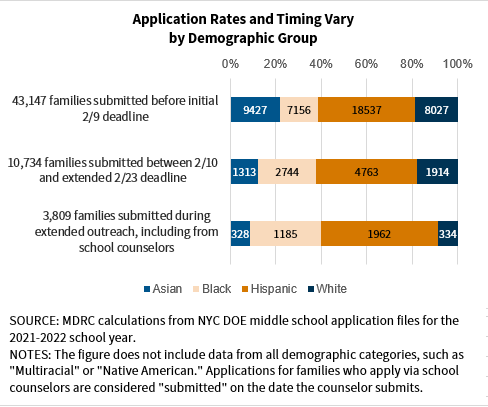How New York City Tackled School Application Barriers for Families During the Pandemic—and Beyond

Many school districts across the United States face declining school enrollments in a third school year affected by the COVID-19 pandemic. To address challenges related to the pandemic and better meet families’ needs, some districts have adopted new approaches to application, admissions, and enrollment processes. Changes include relaxing admissions requirements, extending application timelines, and proactively reaching families to ensure families who want to stay within the district can do so.
This brief describes changes that New York City Department of Education (NYC DOE) implemented during the 2020-21 school year for middle school admissions related to family outreach and application processes (separate from admission rules). Unlike in many districts, NYC offers a choice-based system for middle school enrollment.[1] These changes were implemented as part of the Lab for Equity and Engagement in School Enrollment (the E3 Lab)—a partnership with nonprofit research firm MDRC to address application and enrollment barriers (see box). This brief focuses on lessons related to improving outreach and digital application processes from this COVID-affected year in NYC and how they could apply longer term. NYC’s experience could also help inform the policies and practices of other districts.
Where Did Families Get Stuck, and How Did NYC DOE Respond?
The E3 Lab worked on identifying “pain points” faced by families of rising middle-schoolers during the pandemic, based on data from interviews, surveys, and other NYC DOE interactions with families. This process and decision map illustrates the Lab’s systematic approach to understanding which families may face barriers and to guiding changes that address the pain points. The examples below describe how NYC DOE anticipated some of those barriers and responded to others. Note that due to the pandemic-related closure of physical spaces where families would have previously been able to seek assistance—such as schools, school fairs, and NYC DOE Family Welcome Centers[2]—most of the interventions to promote participation in school application were digital:
Automatic account creation for some families applying to middle school: In 2018, NYC DOE introduced MySchools (MySchools.nyc), an online platform where families can learn about schools and submit their applications for each transition grade (3-K, pre-K, kindergarten, middle school, and high school). However, some families didn’t realize they could submit a middle school application on their own by creating a MySchools account. In January 2021, NYC DOE piloted automatic account creation for approximately 12,000 middle school applicant families, removing a barrier in the process. This change in the default process may have been especially helpful for parents who were confused about having multiple NYC DOE accounts related to their child’s education—one for instruction, another for academic records and school updates, and another (MySchools) for school directories and applications.
Proactive outreach to families with incomplete applications: NYC DOE staff reviewed data during the application period to identify which families had “started but not submitted” applications. The Lab then created tailored messages to prompt action. In addition, the middle school admissions team prompted elementary school counselors to reach out to families who had not applied by the deadline, to see if they were facing technology challenges or needed additional information or support. More proactive and customized outreach may have been a crucial point of interaction with NYC DOE for some families, especially during the pandemic. One parent said: “Being a first-time parent applying for middle school was a bit confusing at first until I was guided [through] the process [by] the school guidance counselor.”[3]
Looking at application data, the Lab noted that a higher share of Black and Hispanic families than others applied for middle school during periods of extended outreach (see bottom row of the figure). Applying past the deadline does not necessarily reflect a lack of interest in the school application process, but rather the logistical difficulties that families may have faced. Overall, three-quarters of families, regardless of race or ethnicity, applied by the initial deadline.

Frequent digital communication about changing processes: As policies and processes changed and application timelines shifted, NYC DOE sent emails and posted social media to update and support families before, during, and after the application process. For the first time, DOE ensured that all “blast” communications were translated into nine languages to provide direct access to information for more families in their home language. With print budgets eliminated during the pandemic and most middle school students learning remotely most of the year, the DOE created a video series for each admissions process, including tutorials for how to use MySchools.[4] One parent said about the additional information and outreach: “I feel like the office of enrollment made more explanation available than I have ever seen previously.”
E3 Lab’s Recommendations for Future Admissions Cycles in NYC
The examples above illustrate some of the ways NYC DOE learned and adapted to improve its middle school admissions process during a challenging time. The E3 Lab offers the following recommendations (developed in collaboration with the NYC DOE teams responsible for implementing them) for continued improvement:
- Proactive outreach to families. By engaging families with concrete admissions information well before the application opens––as well as through “blast” and targeted campaigns just before and during the process—NYC DOE could prevent some of the confusion that stops families from either starting or completing applications. This type of early outreach may be useful in addition to—or even instead of—extending deadlines. The Lab recommends tailoring methods of outreach for different segments of the population. NYC DOE may still need to do phone outreach and send postcards for people without emails, given persistent technology limitations in some areas.
- Use ongoing data to make decisions and to adapt digital processes. To target additional outreach, NYC DOE can use this year’s application rates to identify low-applying areas. NYC DOE could build on current efforts to communicate across offices by conducting weekly analyses of data sources, such as visits to Family Welcome Centers or calls to the dedicated enrollment call center P311 during the application period to identify families who may be struggling with the application process, as well as to clarify confusing topics in later emails or sent to families. As DOE’s team that translates communications into languages other than English builds its capacity, DOE could more quickly respond to feedback from call center staff to explain NYC-specific concepts like “zoned school.”
- Identify when and how digital barriers emerge. NYC DOE has heard parents express confusion about having different school-related accounts for grades, for applications, and for other purposes, and about wanting a single sign-on system in the future. One parent reported: “It was very tedious trying to get a hold [of] two different passwords to obtain information on my child. And to get access to two different websites.” The Lab recommends that DOE implement automatic account creation for families more broadly and move towards a single sign-on across parent accounts (for instance, by merging NYC Schools Accounts and MySchools accounts).
The E3 Lab has compiled the changes made in NYC DOE outreach strategy and practices throughout the pandemic into an internal “playbook,” along with tips, templates, and more detail on the recommendations listed here. NYC DOE will continue to update the playbook with emerging strategies as part of continually learning how to better serve families.
Ellie Warner-Rousseau is a research assistant for MDRC’s Center for Applied Behavioral Science, which Rekha Balu directs. Rachel Leopold is the director of Enrollment Research and Policy in New York City’s Department of Education’s Office of Student Enrollment.
Acknowledgments
The authors thank the Michael & Susan Dell Foundation for their generous support in funding the project referenced in this issue focus. Many thanks to our research partners at the New York City Department of Education, particularly to the staff at the Office of Student Enrollment and to Anne Stameshkin for her thoughtful comments and revisions. Thanks to our MDRC colleagues: Jedediah Teres for providing data support; Barbara Condliffe, Caitlin Anzelone, and John Hutchins for their careful reading of draft materials and helpful suggestions to improve the document; and consultant Beth Sullivan for designing the document for the website.
[1]New York City offers families the option to apply to up to 12 non-charter public schools, rather than directing parents only to their neighborhood schools. If families do not apply, they will likely be automatically enrolled in their “zoned” middle school. Some families may choose not to apply if they want to attend their zoned school, if they are moving out of New York City, or if they are planning to attend charter or private schools. For additional context on New York City’s school application and enrollment processes, see Rekha Balu, Barbara Condliffe, and Margaret Hennessy, Kindergarten Outreach, Application, and Enrollment: Lessons Learned from a Research-Practice Partnership with New York City’s Department of Education (New York: MDRC, 2021).
[2]Family Welcome Centers are drop-in spaces where families can seek assistance from NYC DOE staff on application and enrollment questions. Families can currently seek assistance by calling, emailing, or scheduling an in-person appointment.
[3]All quotes are from families who submitted a middle school application to enter school in fall of 2021 and who wrote comments in a post-application survey.
[4]The middle school admissions video series is featured as a playlist at schools.nyc.gov/Middle.






